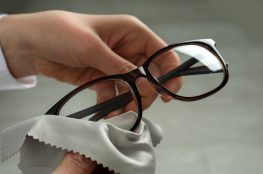If something changes gradually, we may not initially notice. But we will eventually notice when the change becomes extreme. This phenomenon applies to our eyesight. We may not realise that we no longer see quite as clearly as we did in our youth. But the truth is that our vision has been slowly changing over time. If we know the signs to look for, we can catch this early on, perhaps preventing it from becoming worse. We will basically be better off if we use a glasses or contacts from the optometrist.
Signs of Vision Change
Many individuals are unaware that they may have a vision problem until it begins to significantly impact their daily lives. Recognizing the early signs of vision issues is important for timely intervention and effective treatment
Blurry Vision
We might experience blurry vision in one or both eyes. It will be more noticeable if the two eyes are different. Blurriness is a common symptom of several vision problems, including near-sightedness (myopia), far-sightedness (hyperopia), and astigmatism.
Frequent Headaches
Headaches, especially after long term use of a screen or reading, is a common symptom of eye strain or uncorrected vision problems, most probably far-sightedness. This straining to see clearly puts extra stress on the eye muscles, causing discomfort and headaches. Over time the straining seems to make the eyesight problem worse. Often, reading glasses are enough to prevent the headaches, and help to prevent the vision issues from getting worse.
Squinting
We might find ourselves unconsciously squinting in an attempt to improve our focus and clarity. This partially works because it temporarily changes the shape of your eye, helping to focus light better, and filters our some of the small detail in what we see. If you catch yourself or your child squinting, it’s time for an eye check-up.
Double Vision
Seeing double images, also known as diplopia, can be a symptom of various eye conditions, including strabismus (misalignment of the eyes) or issues with the cornea or lens. Double vision should be evaluated by an optometrist promptly.
Difficulty Seeing at Night
Some of us struggle to see clearly in low light conditions or have trouble driving at night. This is night blindness (nyctalopia). It can be caused by a deficiency in vitamin A, early forming cataracts, or other vision problems. Optometrists will have the best treatment, which can help maintain your eyesight.
Eye Fatigue
Eye fatigue, or asthenopia, is common among individuals who spend long periods of time digital devices. Symptoms include tired, aching eyes, and difficulty focusing. This could be a sign of digital eye strain or there might be other underlying vision issues. Sometimes this can be prevented with a blue light filter on glasses or the screen.
Halos and Glare
Seeing halos around lights or experiencing glare can be a sign of cataracts or other eye conditions. These symptoms often indicate that light is not being properly focused onto the retina.
Floaters and Flashes
While an occasional floater (small specks or strands in your vision) are normal, a sudden increase in floaters or flashes of light could be a sign of retinal detachment, which requires immediate medical attention.
Reading Problems
If you find yourself holding books or screens closer or farther away than usual, or if letters appear to jump or move, you may have a focusing problem or a binocular vision issue. This is especially common in children with undiagnosed vision problems.
Common Vision Issues and Corrective Measures
Near-sightedness (Myopia)
Nearsighted individuals can see close objects clearly, but distant objects appear blurry. This is often corrected with prescription glasses or contact lenses. Refractive surgery, such as LASIK, is another option for eligible patients.
Farsightedness (Hyperopia)
Farsighted people can see distant objects well, but struggle with close-up tasks. Corrective measures include prescription glasses or contact lenses designed to improve near vision.
Astigmatism
Astigmatism is caused by an irregularly shaped cornea or lens, leading to blurred or distorted vision. Corrective measures include specially designed toric lenses in glasses or contact lenses, and refractive surgery.
Presbyopia
Presbyopia is an age-related condition where the eye’s lens loses flexibility, making it difficult to focus on close objects. Reading glasses, bifocals, or multifocal contact lenses are common corrective options.
Strabismus
Strabismus, or crossed eyes, occurs when the eyes do not align properly. Treatment options include corrective glasses, eye exercises, or surgery, depending on the severity and underlying cause.
Conclusion
Remember, regular eye check-ups help maintain good vision, and can provide early detect of any issues. If we recognise the signs of vision issues early on we should see our optometrist. Proper treatment can significantly improve your quality of life and prevent more serious vision problems as we age. If you experience any of the symptoms mentioned above, it’s important to schedule an eye examination with your Sydney optometrist. Don’t wait until symptoms become severe; take proactive steps to ensure your eyes remain healthy and that your vision stays clear.
Information Disclaimer
The content of this article is meant for informational purposes only and should not be considered a source of professional advice, recommendations, or endorsements. It is not a substitute for seeking expert guidance or making well-informed decisions based on individual circumstances. Although we strive for accuracy and reliability, we cannot guarantee the information's completeness or suitability for all situations. Readers are urged to verify facts, consult experts, and consider their own context before taking actions or decisions based on this content. No warranties, explicit or implied, are provided regarding the accuracy, timeliness, or completeness of the presented information. Relying on this information is at the reader's own discretion and risk. We encourage readers to consult relevant professionals or experts for advice tailored to their specific needs. Neither the author, publisher, nor any affiliated parties will be held responsible for errors, omissions, or damages resulting from the use or reliance on the information in this article.



